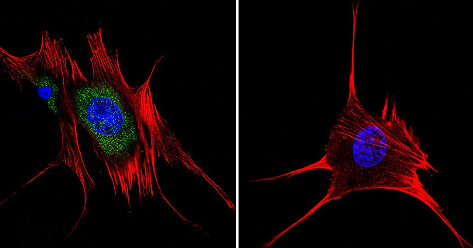
Immunofluorescent analysis of Aryl Hydrocarbon Receptor in NIH-3T3 cells. Cells were grown on chamber slides and fixed with formaldehyde prior to staining. Cells were probed without (control, right) or with a Aryl Hydrocarbon Receptor monoclonal antibody (ab2770, left) at a dilution of 1:200 overnight at 4 C and incubated with a DyLight-488 conjugated secondary antibody. Aryl Hydrocarbon Receptor staining (green) F-Actin staining with Phalloidin (red) and nuclei with DAPI (blue) is shown. Images were taken at 60X magnification.
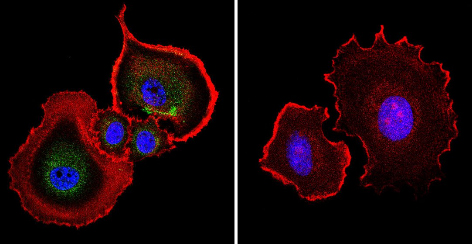
Immunofluorescent analysis of Aryl Hydrocarbon Receptor in MCF-7 cells. Cells were grown on chamber slides and fixed with formaldehyde prior to staining. Cells were probed without (control, right) or with a Aryl Hydrocarbon Receptor monoclonal antibody (ab2770, left) at a dilution of 1:100 overnight at 4 C and incubated with a DyLight-488 conjugated secondary antibody. Aryl Hydrocarbon Receptor staining (green) F-Actin staining with Phalloidin (red) and nuclei with DAPI (blue) is shown. Images were taken at 60X magnification.
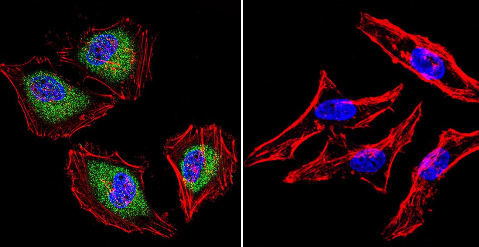
Immunofluorescent analysis of Aryl Hydrocarbon Receptor in HeLa cells. Cells were grown on chamber slides and fixed with formaldehyde prior to staining. Cells were probed without (control, right) or with a Aryl Hydrocarbon Receptor monoclonal antibody (ab2770, left) at a dilution of 1:200 overnight at 4 C and incubated with a DyLight-488 conjugated secondary antibody. Aryl Hydrocarbon Receptor staining (green) F-Actin staining with Phalloidin (red) and nuclei with DAPI (blue) is shown. Images were taken at 60X magnification.
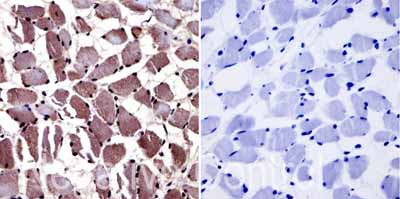
Immunohistochemistry was performed on normal biopsies of deparaffinized Human skeletal muscle tissue. To expose target proteins heat induced antigen retrieval was performed using 10mM sodium citrate (pH6.0) buffer and microwaved for 8-15 minutes. Following antigen retrieval tissues were blocked in 3% BSA-PBS for 30 minutes at room temperature and probed with a Aryl Hydrocarbon Receptor monoclonal antibody (ab2770) at a dilution of 1:20 or without primary antibody (negative control) overnight at 4�C in a humidified chamber. Tissues were washed with PBST and endogenous peroxidase activity was quenched with a peroxidase suppressor. Detection was performed using a biotin-conjugated secondary antibody and SA-HRP followed by colorimetric detection using DAB. Tissues were counterstained with hematoxylin and prepped for mounting.
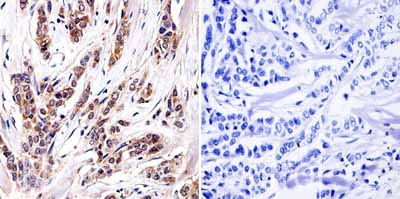
Immunohistochemistry was performed on cancer biopsies of deparaffinized Human breast carcinoma tissue. To expose target proteins heat induced antigen retrieval was performed using 10mM sodium citrate (pH6.0) buffer and microwaved for 8-15 minutes. Following antigen retrieval tissues were blocked in 3% BSA-PBS for 30 minutes at room temperature and probed with a Aryl Hydrocarbon Receptor monoclonal antibody (ab2770) at a dilution of 1:100 or without primary antibody (negative control) overnight at 4�C in a humidified chamber. Tissues were washed with PBST and endogenous peroxidase activity was quenched with a peroxidase suppressor. Detection was performed using a biotin-conjugated secondary antibody and SA-HRP followed by colorimetric detection using DAB. Tissues were counterstained with hematoxylin and prepped for mounting.

ab2770 staining aryl hydrocarbon receptor in MDA-MB-231 cells treated with nifedipine (ab120135), by ICC/IF. Increase in aryl hydrocarbon receptor expression correlates with increased concentration of nifedipine, as described in literature.The cells were incubated at 37°C for 6h in media containing different concentrations of ab120135 (nifedipine) in DMSO, fixed with 100% methanol for 5 minutes at -20°C and blocked with PBS containing 10% goat serum, 0.3 M glycine, 1% BSA and 0.1% tween for 2h at room temperature. Staining of the treated cells with ab2770 (1/100 dilution) was performed overnight at 4°C in PBS containing 1% BSA and 0.1% tween. A DyLight 488 goat anti-mouse polyclonal antibody (ab96879) at 1/250 dilution was used as the secondary antibody. Nuclei were counterstained with DAPI and are shown in blue.
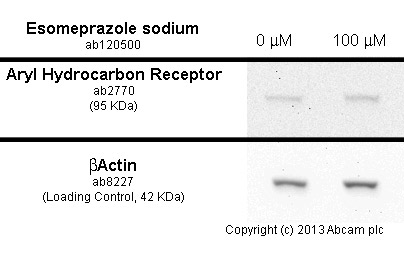
developed using the ECL techniquePerformed under reducing conditions.
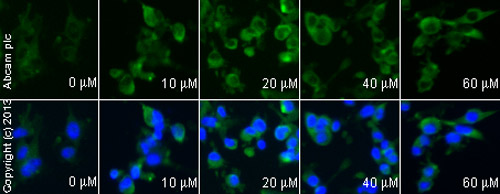
ab2770 staining aryl hydrocarbon receptor in MDA-MB-231 cells treated with nitrendipine (ab120139), by ICC/IF. Increase in aryl hydrocarbon receptor expression correlates with increased concentration of nitrendipine, as described in literature.The cells were incubated at 37°C for 6h in media containing different concentrations of ab120139 (nitrendipine) in DMSO, fixed with 100% methanol for 5 minutes at -20°C and blocked with PBS containing 10% goat serum, 0.3 M glycine, 1% BSA and 0.1% tween for 2h at room temperature. Staining of the treated cells with ab2770 (1/100 dilution) was performed overnight at 4°C in PBS containing 1% BSA and 0.1% tween. A DyLight 488 goat anti-mouse polyclonal antibody (ab96879) at 1/250 dilution was used as the secondary antibody. Nuclei were counterstained with DAPI and are shown in blue.
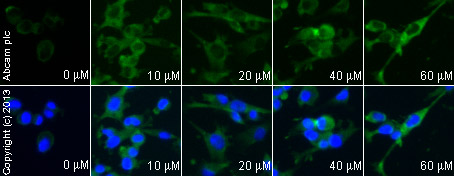
ab2770 staining aryl hydrocarbon receptor in MDA-MB-231 cells treated with nimodipine (ab120138), by ICC/IF. Increase in aryl hydrocarbon receptor expression correlates with increased concentration of nimodipine, as described in literature.The cells were incubated at 37°C for 6h in media containing different concentrations of ab120138 (nimodipine) in DMSO, fixed with 100% methanol for 5 minutes at -20ºC and blocked with PBS containing 10% goat serum, 0.3 M glycine, 1% BSA and 0.1% tween for 2h at room temperature. Staining of the treated cells with ab2770 (1/100 dilution) was performed overnight at 4°C in PBS containing 1% BSA and 0.1% tween. A DyLight 488 goat anti-mouse polyclonal antibody (ab96879) at 1/250 dilution was used as the secondary antibody. Nuclei were counterstained with DAPI and are shown in blue.
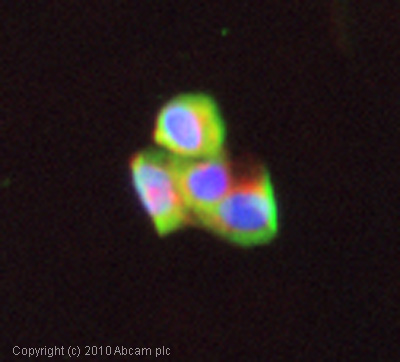
ICC/IF image of ab2770 stained Mcf7 cells. The cells were 4% formaldehyde fixed (10 min) and then incubated in 1%BSA / 10% normal goat serum / 0.3M glycine in 0.1% PBS-Tween for 1h to permeabilise the cells and block non-specific protein-protein interactions. The cells were then incubated with the antibody (ab2770, at a 1/1000 dilution) overnight at +4°C. The secondary antibody (green) was Alexa Fluor® 488 goat anti-mouse IgG (H+L) used at a 1/1000 dilution for 1h. Alexa Fluor® 594 WGA was used to label plasma membranes (red) at a 1/200 dilution for 1h. DAPI was used to stain the cell nuclei (blue) at a concentration of 1.43µM.
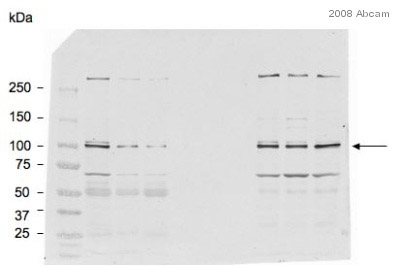
![Overlay histogram showing HEK293 cells stained with ab2770 (red line). The cells were fixed with 4% paraformaldehyde (10 min) and then permeabilized with 0.1% PBS-Tween for 20 min. The cells were then incubated in 1x PBS / 10% normal goat serum / 0.3M glycine to block non-specific protein-protein interactions. The cells were then incubated with the antibody (ab2770, 1/100 dilution) for 30 min at 22ºC. The secondary antibody used was DyLight® 488 goat anti-mouse IgG (H+L) (ab96879) at 1/500 dilution for 30 min at 22ºC. Isotype control antibody (black line) was mouse IgG1 [ICIGG1] (ab91353, 2µg/1x106 cells ) used under the same conditions. Acquisition of >5,000 events was performed. This antibody gave a positive signal in HEK293 cells fixed with 80% methanol (5 min)/permeabilized in 0.1% PBS-Tween used under the same conditions.](http://www.bioprodhub.com/system/product_images/ab_products/2/sub_1/9980_Aryl-hydrocarbon-Receptor-Primary-antibodies-ab2770-7.jpg)
Overlay histogram showing HEK293 cells stained with ab2770 (red line). The cells were fixed with 4% paraformaldehyde (10 min) and then permeabilized with 0.1% PBS-Tween for 20 min. The cells were then incubated in 1x PBS / 10% normal goat serum / 0.3M glycine to block non-specific protein-protein interactions. The cells were then incubated with the antibody (ab2770, 1/100 dilution) for 30 min at 22ºC. The secondary antibody used was DyLight® 488 goat anti-mouse IgG (H+L) (ab96879) at 1/500 dilution for 30 min at 22ºC. Isotype control antibody (black line) was mouse IgG1 [ICIGG1] (ab91353, 2µg/1x106 cells ) used under the same conditions. Acquisition of >5,000 events was performed. This antibody gave a positive signal in HEK293 cells fixed with 80% methanol (5 min)/permeabilized in 0.1% PBS-Tween used under the same conditions.











![Overlay histogram showing HEK293 cells stained with ab2770 (red line). The cells were fixed with 4% paraformaldehyde (10 min) and then permeabilized with 0.1% PBS-Tween for 20 min. The cells were then incubated in 1x PBS / 10% normal goat serum / 0.3M glycine to block non-specific protein-protein interactions. The cells were then incubated with the antibody (ab2770, 1/100 dilution) for 30 min at 22ºC. The secondary antibody used was DyLight® 488 goat anti-mouse IgG (H+L) (ab96879) at 1/500 dilution for 30 min at 22ºC. Isotype control antibody (black line) was mouse IgG1 [ICIGG1] (ab91353, 2µg/1x106 cells ) used under the same conditions. Acquisition of >5,000 events was performed. This antibody gave a positive signal in HEK293 cells fixed with 80% methanol (5 min)/permeabilized in 0.1% PBS-Tween used under the same conditions.](http://www.bioprodhub.com/system/product_images/ab_products/2/sub_1/9980_Aryl-hydrocarbon-Receptor-Primary-antibodies-ab2770-7.jpg)